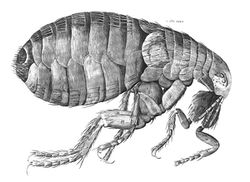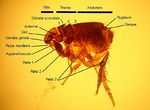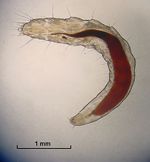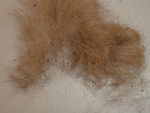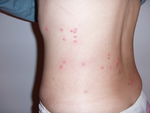Difference between revisions of "Fleas"
(Redirected page to Category:Fleas) |
|||
| (27 intermediate revisions by 3 users not shown) | |||
| Line 1: | Line 1: | ||
| + | {{review}} | ||
| − | # | + | {{toplink |
| + | |backcolour = | ||
| + | |linkpage =Insecta | ||
| + | |linktext =INSECTA | ||
| + | |pagetype=Bugs | ||
| + | |sublink1=Parasites | ||
| + | |subtext1=PARASITES | ||
| + | }} | ||
| + | <br> | ||
| + | [[Image: flea.jpg|thumb|right|250px|Robert Hooke's famous flea from Micrographia]] | ||
| + | ==Siphonaptera Introduction== | ||
| + | [[Image:Arthropod classifiation.jpg|thumb|right|150px|Arthropod Classification - copyright nabrown RVC]] | ||
| + | Fleas are wingless insects that are laterally flattened so can move rapidly through hair and fur. Their hind legs are adapted for jumping. They are of major significance to veterinary practice and are seen on a daily basis at most general practices. | ||
| + | |||
| + | Adult fleas are blood sucking ectoparasites which can cause pruritis, annoyance, loss of condition and anaemia if present in large numbers. [[Skin Immunologic - Pathology#Flea bite hypersensitivity|Flea allergic dermatitis]] can also occur where the animal becomes allergic to the antigens in the flea saliva triggering a hypersensitivity reaction when the flea bites. | ||
| + | |||
| + | Fleas can also act as intermediate hosts for the tapeworm [[Dipylidium|''Dipylidium'']] and as an important vector for diseases such as cat scratch disease, the bubonic plague and [[Myxomatosis|myxomatosis]]. | ||
| + | |||
| + | The terms '''ctenidia''' and '''combs''' can be used interchangably for spines on the head/thorax. Spines on the cheeks are referred to as '''genal''' and spines on the thorax are called '''pronotal''' combs. The presence and location of the chitinous spines are important in differentiating between the different flea species. The chitinous anal struts are also used for identification and help the flea larvae with vigorous motility. | ||
| + | |||
| + | ==Species of veterinary importance== | ||
| + | |||
| + | ===''Ctenocephalides felis''=== | ||
| + | [[Image:Cat flea.jpg|thumb|right|150px|Cat Flea - Andy Brookes BS - Wikimedia Commons]] | ||
| + | *Most common flea on both cats and dogs | ||
| + | |||
| + | *Most important flea in veterinary medicine | ||
| + | |||
| + | *Commonly called the 'cat flea' | ||
| + | |||
| + | *Can bite humans and other animals | ||
| + | |||
| + | *Both genal and pronotal commbs present | ||
| + | |||
| + | *Similar length genal combs | ||
| + | |||
| + | *The first genal spine is 0.75 times the length of the second | ||
| + | |||
| + | *Sloping nose | ||
| + | |||
| + | ===''Ctenocephalides canis''=== | ||
| + | |||
| + | *Less common | ||
| + | |||
| + | *Commonly called the 'dog flea' | ||
| + | |||
| + | *Host specific | ||
| + | |||
| + | *Both genal and pronotal commbs present | ||
| + | |||
| + | *Irregular length genal spines | ||
| + | |||
| + | *Rounded nose | ||
| + | |||
| + | ===''Ceratophyllus gallinae''=== | ||
| + | |||
| + | *Commonly called the 'poultry flea' | ||
| + | |||
| + | *Bites humans and other animals | ||
| + | |||
| + | *Pronotal combs only | ||
| + | |||
| + | ===''Pulex irritans''=== | ||
| + | |||
| + | *Commonly called the 'human flea' | ||
| + | |||
| + | *No combs | ||
| + | |||
| + | *Head rounded anteriorly | ||
| + | |||
| + | ===''Spilopsyllus cuniculi''=== | ||
| + | |||
| + | *Commonly called the 'rabbit flea' | ||
| + | |||
| + | *Both genal and pronotal combs present | ||
| + | |||
| + | *Genal comb obviously oblique | ||
| + | |||
| + | *Behaviour synchronised with the reproductive cycle of the rabbit | ||
| + | **Adults spend most of their time off the host taking occasional blood feeds | ||
| + | **Shortly before the doe gives birth the adult fleas attach to the ears of the rabbit and feed producing lots of faeces | ||
| + | **After parturition the adult fleas move onto the kittens where they feed, mate and lay eggs | ||
| + | **The new adult fleas emerge from the pupa before the kittens leave the nest | ||
| + | |||
| + | ===Other important flea species=== | ||
| + | |||
| + | *Fleas of wildlife can sometimes infect domestic animals | ||
| + | |||
| + | *Other species of importance are found in America | ||
| + | **E.g. ''Tunga penetrans'' or 'Jiggers' which burrow into the skin of man (also called the 'sand flea' or 'chigoe flea') | ||
| + | |||
| + | *''Nosopsyllus fasciatus'' | ||
| + | **Affects rodents | ||
| + | **18-20 spines in pronotal ctenidium | ||
| + | |||
| + | *''Echisnophaga gallinacea'' | ||
| + | **Affects poultry | ||
| + | **Frons (forehead) angled anteriorly | ||
| + | **Also called the 'sticktight' flea | ||
| + | |||
| + | *''Archaeopsylla erinacei'' | ||
| + | **Affects hedgehogs | ||
| + | **1-3 short spines on genal ctendium | ||
| + | **1 short spine on pronotal ctenidium | ||
| + | |||
| + | ==Life-cycle== | ||
| + | [[Image:Flea larvae.jpg|thumb|right|150px|Flea Larvae - Wikimedia Commons]] | ||
| + | A thorough understanding of the flea life-cycle is important in order to be able to advise owners of adequate treatments to control flea infections on their animals and within the home environment. | ||
| + | |||
| + | *The time for the egg to develop into the adult flea takes '''3-4 weeks''' in summer | ||
| + | |||
| + | *Duration of the life cycle is dependent on environmental temperature | ||
| + | |||
| + | '''1. Adults''' | ||
| + | |||
| + | *Uses changes in light intensity, warmth and carbon dioxide to locate host | ||
| + | |||
| + | *Once on host, the flea will usually remain | ||
| + | **With animals in close contact there may be a small degree of transfer between hosts | ||
| + | **The majority of adult fleas are acquired from the '''environment''' | ||
| + | |||
| + | *The adult flea takes frequent blood meals | ||
| + | |||
| + | *'''Flea dirt''' (faeces) are produced in large quantities | ||
| + | |||
| + | *The life span of the flea is determined by the grooming activity of the host | ||
| + | **Usually the adult flea lives for between '''7 and 10 days''' | ||
| + | |||
| + | '''2. Eggs''' | ||
| + | |||
| + | *The adult lays eggs 1-2 days after locating a host | ||
| + | |||
| + | *Approximately '''15 eggs''' are layed in the coat per day | ||
| + | |||
| + | *Eggs are ivory white, oval and approxiamtely 0.5mm long | ||
| + | |||
| + | *The eggs drop to the ground within hours | ||
| + | **In reality this usually happens when the animal jumps of the sofa or makes sudden movements. Flea eggs will therefore cluster in these '''hot spots''' around the house. These areas should be paid particular attention when treating the environment in the case of a flea infestation. | ||
| + | |||
| + | '''3. Larvae''' | ||
| + | |||
| + | *Larvae are small, about 2-5mm in length | ||
| + | |||
| + | *Larvae are yellow/white (look like maggots) and are covered in bristles | ||
| + | |||
| + | *They have chitinous mouthparts and anal struts which can be used for identification | ||
| + | |||
| + | *Larvae are negatively phototropic so try to move away from light sources | ||
| + | **E.g. under furniture, into thick mats or carpet | ||
| + | |||
| + | *Larvae feed on skin debris from other animals, flea dirt and other organic debris | ||
| + | |||
| + | *High humidity is needed for survival | ||
| + | |||
| + | *Freezing temperatures will kill larvae | ||
| + | |||
| + | '''4. Pupae''' | ||
| + | |||
| + | *The larvae pupate forming pupae of 5mm in length | ||
| + | |||
| + | *A silken cocoon surrounds the pupae | ||
| + | **Slightly sticky so small particles adhere to it | ||
| + | **These quickly become camouflaged in the environment | ||
| + | |||
| + | *Methoprene, the juvenile development hormone coordinates the growth of the immature stages | ||
| + | **Activates genetic switches | ||
| + | **Determines the sequence of tissue and organ development | ||
| + | |||
| + | *Newly developed adults do not leave the cocoon straight away | ||
| + | **The '''pupal window''' is the time that it takes for the adult to emerge | ||
| + | **Temperature determines when the adult fleas emerge | ||
| + | **Some fleas may wait several months before emerging | ||
| + | |||
| + | *Newly emerged unfed adults can survive days without feeding but once they have fed, if they fall off the host they can only survive hours | ||
| + | |||
| + | ==Habitats== | ||
| + | |||
| + | *Only approximately '''5%''' of the flea population will be on the animal at any one time (and usually it is a much smaller percentage) | ||
| + | |||
| + | *The rest of the population are in the '''environment''' | ||
| + | **E.g. Eggs, larvae, pupae and unfed adults | ||
| + | |||
| + | *Fleas accumulate in certain '''hot spots''' where the animal spends the majority of its time | ||
| + | **E.g. Warm, shady, humid ares | ||
| + | **E.g. Outdoors in warmer climates or inside in temperate climates | ||
| + | |||
| + | *Very large numbers of eggs are found in areas where cats land after jumping as they have been dislodged | ||
| + | **E.g. Beside sofas | ||
| + | |||
| + | ==Control== | ||
| + | [[Image:Flea Dirt.jpg|thumb|right|150px|Flea Dirt - Wikimedia Commons]] | ||
| + | [[Image:Flea Bites.jpg|right|Thumb|150px|Flea bites on a human - Wikimedia Commons]] | ||
| + | *Single or occasional treatments will only give temporary relief from fleas as the majority of the population is '''in the environment''' | ||
| + | |||
| + | *Appropriate action must be taken to stop re-infestation | ||
| + | |||
| + | *The animal must be rid of its resident flea population | ||
| + | |||
| + | *The animal should be protected against subsequent re-infestation | ||
| + | **From within the home | ||
| + | **From outside the home | ||
| + | |||
| + | *The environmental reservoir population should be eliminated | ||
| + | **Animal treatment to deplete reservoir | ||
| + | ***Adulticides | ||
| + | ***Adulticides with larvicidal effects | ||
| + | ***Insect growth regulators (IGR's) | ||
| + | **Direct chemical treatment of domestic environment | ||
| + | ***Insecticides | ||
| + | ***Insect growth regulators | ||
| + | ***Inorganic chemicals | ||
| + | ***Entomorphagous nematodes | ||
| + | |||
| + | *To prevent resistance occurring, control methods should not rely solely on chemical methods | ||
| + | **Hygiene such as regular vacuuming and washing of the animal's bedding should also occur for the most effective treatment | ||
| + | |||
| + | *For more information on the chemicals used for flea treatment click [[Ectoparasiticides|here]] | ||
| + | |||
| + | ==[[Insecta Flashcards - WikiBugs#Fleas|Fleas Flashcards]]== | ||
| + | |||
| + | ==Links== | ||
| + | ''Internal'' | ||
| + | *[[Skin Immunologic - Pathology#Flea bite hypersensitivity|Flea allergic dermatitis (FAD)]] | ||
| + | |||
| + | *Fleas act as intermediate hosts for [[Dipylidium|'''''Dipylidium'' tapeworms''']] | ||
| + | |||
| + | *Fleas act as vectors for [[Poxviruses#Myxoma virus|myxomatosis]] in rabbits | ||
| + | |||
| + | ''External'' | ||
| + | *[http://en.wikipedia.org/wiki/Flea Wikipedia- Fleas] | ||
Revision as of 15:49, 31 August 2009
| This article has been peer reviewed but is awaiting expert review. If you would like to help with this, please see more information about expert reviewing. |
|
|
Siphonaptera Introduction
Fleas are wingless insects that are laterally flattened so can move rapidly through hair and fur. Their hind legs are adapted for jumping. They are of major significance to veterinary practice and are seen on a daily basis at most general practices.
Adult fleas are blood sucking ectoparasites which can cause pruritis, annoyance, loss of condition and anaemia if present in large numbers. Flea allergic dermatitis can also occur where the animal becomes allergic to the antigens in the flea saliva triggering a hypersensitivity reaction when the flea bites.
Fleas can also act as intermediate hosts for the tapeworm Dipylidium and as an important vector for diseases such as cat scratch disease, the bubonic plague and myxomatosis.
The terms ctenidia and combs can be used interchangably for spines on the head/thorax. Spines on the cheeks are referred to as genal and spines on the thorax are called pronotal combs. The presence and location of the chitinous spines are important in differentiating between the different flea species. The chitinous anal struts are also used for identification and help the flea larvae with vigorous motility.
Species of veterinary importance
Ctenocephalides felis
- Most common flea on both cats and dogs
- Most important flea in veterinary medicine
- Commonly called the 'cat flea'
- Can bite humans and other animals
- Both genal and pronotal commbs present
- Similar length genal combs
- The first genal spine is 0.75 times the length of the second
- Sloping nose
Ctenocephalides canis
- Less common
- Commonly called the 'dog flea'
- Host specific
- Both genal and pronotal commbs present
- Irregular length genal spines
- Rounded nose
Ceratophyllus gallinae
- Commonly called the 'poultry flea'
- Bites humans and other animals
- Pronotal combs only
Pulex irritans
- Commonly called the 'human flea'
- No combs
- Head rounded anteriorly
Spilopsyllus cuniculi
- Commonly called the 'rabbit flea'
- Both genal and pronotal combs present
- Genal comb obviously oblique
- Behaviour synchronised with the reproductive cycle of the rabbit
- Adults spend most of their time off the host taking occasional blood feeds
- Shortly before the doe gives birth the adult fleas attach to the ears of the rabbit and feed producing lots of faeces
- After parturition the adult fleas move onto the kittens where they feed, mate and lay eggs
- The new adult fleas emerge from the pupa before the kittens leave the nest
Other important flea species
- Fleas of wildlife can sometimes infect domestic animals
- Other species of importance are found in America
- E.g. Tunga penetrans or 'Jiggers' which burrow into the skin of man (also called the 'sand flea' or 'chigoe flea')
- Nosopsyllus fasciatus
- Affects rodents
- 18-20 spines in pronotal ctenidium
- Echisnophaga gallinacea
- Affects poultry
- Frons (forehead) angled anteriorly
- Also called the 'sticktight' flea
- Archaeopsylla erinacei
- Affects hedgehogs
- 1-3 short spines on genal ctendium
- 1 short spine on pronotal ctenidium
Life-cycle
A thorough understanding of the flea life-cycle is important in order to be able to advise owners of adequate treatments to control flea infections on their animals and within the home environment.
- The time for the egg to develop into the adult flea takes 3-4 weeks in summer
- Duration of the life cycle is dependent on environmental temperature
1. Adults
- Uses changes in light intensity, warmth and carbon dioxide to locate host
- Once on host, the flea will usually remain
- With animals in close contact there may be a small degree of transfer between hosts
- The majority of adult fleas are acquired from the environment
- The adult flea takes frequent blood meals
- Flea dirt (faeces) are produced in large quantities
- The life span of the flea is determined by the grooming activity of the host
- Usually the adult flea lives for between 7 and 10 days
2. Eggs
- The adult lays eggs 1-2 days after locating a host
- Approximately 15 eggs are layed in the coat per day
- Eggs are ivory white, oval and approxiamtely 0.5mm long
- The eggs drop to the ground within hours
- In reality this usually happens when the animal jumps of the sofa or makes sudden movements. Flea eggs will therefore cluster in these hot spots around the house. These areas should be paid particular attention when treating the environment in the case of a flea infestation.
3. Larvae
- Larvae are small, about 2-5mm in length
- Larvae are yellow/white (look like maggots) and are covered in bristles
- They have chitinous mouthparts and anal struts which can be used for identification
- Larvae are negatively phototropic so try to move away from light sources
- E.g. under furniture, into thick mats or carpet
- Larvae feed on skin debris from other animals, flea dirt and other organic debris
- High humidity is needed for survival
- Freezing temperatures will kill larvae
4. Pupae
- The larvae pupate forming pupae of 5mm in length
- A silken cocoon surrounds the pupae
- Slightly sticky so small particles adhere to it
- These quickly become camouflaged in the environment
- Methoprene, the juvenile development hormone coordinates the growth of the immature stages
- Activates genetic switches
- Determines the sequence of tissue and organ development
- Newly developed adults do not leave the cocoon straight away
- The pupal window is the time that it takes for the adult to emerge
- Temperature determines when the adult fleas emerge
- Some fleas may wait several months before emerging
- Newly emerged unfed adults can survive days without feeding but once they have fed, if they fall off the host they can only survive hours
Habitats
- Only approximately 5% of the flea population will be on the animal at any one time (and usually it is a much smaller percentage)
- The rest of the population are in the environment
- E.g. Eggs, larvae, pupae and unfed adults
- Fleas accumulate in certain hot spots where the animal spends the majority of its time
- E.g. Warm, shady, humid ares
- E.g. Outdoors in warmer climates or inside in temperate climates
- Very large numbers of eggs are found in areas where cats land after jumping as they have been dislodged
- E.g. Beside sofas
Control
- Single or occasional treatments will only give temporary relief from fleas as the majority of the population is in the environment
- Appropriate action must be taken to stop re-infestation
- The animal must be rid of its resident flea population
- The animal should be protected against subsequent re-infestation
- From within the home
- From outside the home
- The environmental reservoir population should be eliminated
- Animal treatment to deplete reservoir
- Adulticides
- Adulticides with larvicidal effects
- Insect growth regulators (IGR's)
- Direct chemical treatment of domestic environment
- Insecticides
- Insect growth regulators
- Inorganic chemicals
- Entomorphagous nematodes
- Animal treatment to deplete reservoir
- To prevent resistance occurring, control methods should not rely solely on chemical methods
- Hygiene such as regular vacuuming and washing of the animal's bedding should also occur for the most effective treatment
- For more information on the chemicals used for flea treatment click here
Fleas Flashcards
Links
Internal
- Fleas act as intermediate hosts for Dipylidium tapeworms
- Fleas act as vectors for myxomatosis in rabbits
External
